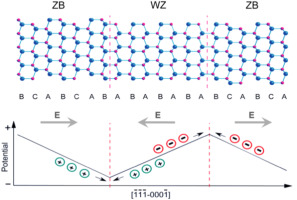当前位置:
X-MOL 学术
›
Nano Energy
›
论文详情
Our official English website, www.x-mol.net, welcomes your feedback! (Note: you will need to create a separate account there.)
Polarization-induced Saw-tooth-like Potential Distribution in Zincblende-Wurtzite Superlattice for Efficient Charge Separation
Nano Energy ( IF 17.6 ) Pub Date : 2017-09-12 , DOI: 10.1016/j.nanoen.2017.09.021 Kai Zhang , Yawen Dai , Zhaohui Zhou , Saad Ullah Jan , Liejin Guo , Jian Ru Gong
Nano Energy ( IF 17.6 ) Pub Date : 2017-09-12 , DOI: 10.1016/j.nanoen.2017.09.021 Kai Zhang , Yawen Dai , Zhaohui Zhou , Saad Ullah Jan , Liejin Guo , Jian Ru Gong

|
Hydrogen production from solar water splitting over semiconductors shows great potential in solving the urgent energy and environmental issues, but its energy conversion efficiency is always restricted by the insufficient utilization of photogenerated charge carriers. Introducing built-in electric fields is a promising strategy for achieving efficient charge utilization in photocatalysts. However, the representative examples of built-in electric fields reported to date all have their own insurmountable shortcomings. Herein, we demonstrated that the zincblende-wurtzite (ZB-WZ) superlattice structure which widely spreads in II-VI and III-V group semiconductors is a promising candidate for the sufficient utilization of photogenerated charge carriers. We developed the ZB-WZ superlattice structures in a model semiconductor photocatalyst, Cd1-xZnxS, by employing the oriented-attachment growth mechanism, and realized highly efficient photocatalytic hydrogen production under visible light irradiation with an excellent apparent quantum yield of 48.7% at 425 nm. Then the huge impact of the ZB-WZ superlattice structure on the photocatalytic performance was proved by the strong reciprocal relationships between the percentage of the nanocrystals with superlattice structures and the photoluminescence intensity, as well as that between the photoluminescence intensity and the photocatalytic activity. Moreover, theoretical simulation demonstrated that the spatial separation and alternate accumulation of electrons and holes around ZB/WZ interfaces is dominated by the polarization-induced saw-tooth potential distribution in the ZB-WZ superlattice rather than the staggered band alignment, and the intensities of built-in electric fields in adjacent ZB and WZ segments can be tuned by changing the specific configuration of the ZB-WZ superlattice. These findings open a new pathway for the development of novel and efficient semiconductor photocatalysts by tuning the superlattice structure with atomic precision, which will greatly benefit the solar water splitting area.
中文翻译:

极化引起的锌闪锌矿-纤锌矿超晶格中的锯齿状电位分布,以实现高效电荷分离
通过分解半导体的太阳能水制氢显示出解决紧急能源和环境问题的巨大潜力,但其能量转换效率始终受到光生电荷载流子利用不足的限制。引入内置电场是实现光催化剂中有效电荷利用的一种有前途的策略。但是,迄今为止报道的内置电场的代表性例子都有其自身无法克服的缺点。在本文中,我们证明了在II-VI和III-V类半导体中广泛分布的闪锌矿-纤锌矿(ZB-WZ)超晶格结构是光生电荷载流子充分利用的有希望的候选者。我们在模型半导体光催化剂Cd中开发了ZB-WZ超晶格结构1-x锌xS,通过采用定向附着生长机理,在可见光照射下实现了高效的光催化制氢,在425 nm处的表观量子产率为48.7%。然后通过具有超晶格结构的纳米晶体的百分数与光致发光强度之间以及光致发光强度与光催化活性之间的强相互关系证明了ZB-WZ超晶格结构对光催化性能的巨大影响。此外,理论模拟表明,ZB / WZ界面周围电子和空穴的空间分离和交替积累主要是由极化引起的ZB-WZ超晶格中的锯齿形电势分布而不是交错带取向引起的,可以通过更改ZB-WZ超晶格的特定配置来调整相邻ZB和WZ段中的内置电场强度。这些发现通过以原子精度调节超晶格结构,为开发新型和高效的半导体光催化剂开辟了一条新途径,这将极大地有利于太阳能分水区。
更新日期:2017-09-12
中文翻译:

极化引起的锌闪锌矿-纤锌矿超晶格中的锯齿状电位分布,以实现高效电荷分离
通过分解半导体的太阳能水制氢显示出解决紧急能源和环境问题的巨大潜力,但其能量转换效率始终受到光生电荷载流子利用不足的限制。引入内置电场是实现光催化剂中有效电荷利用的一种有前途的策略。但是,迄今为止报道的内置电场的代表性例子都有其自身无法克服的缺点。在本文中,我们证明了在II-VI和III-V类半导体中广泛分布的闪锌矿-纤锌矿(ZB-WZ)超晶格结构是光生电荷载流子充分利用的有希望的候选者。我们在模型半导体光催化剂Cd中开发了ZB-WZ超晶格结构1-x锌xS,通过采用定向附着生长机理,在可见光照射下实现了高效的光催化制氢,在425 nm处的表观量子产率为48.7%。然后通过具有超晶格结构的纳米晶体的百分数与光致发光强度之间以及光致发光强度与光催化活性之间的强相互关系证明了ZB-WZ超晶格结构对光催化性能的巨大影响。此外,理论模拟表明,ZB / WZ界面周围电子和空穴的空间分离和交替积累主要是由极化引起的ZB-WZ超晶格中的锯齿形电势分布而不是交错带取向引起的,可以通过更改ZB-WZ超晶格的特定配置来调整相邻ZB和WZ段中的内置电场强度。这些发现通过以原子精度调节超晶格结构,为开发新型和高效的半导体光催化剂开辟了一条新途径,这将极大地有利于太阳能分水区。



























 京公网安备 11010802027423号
京公网安备 11010802027423号